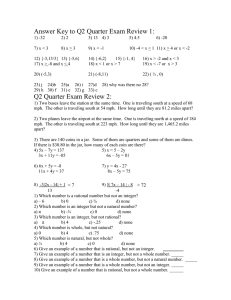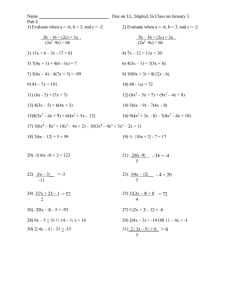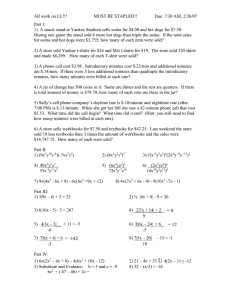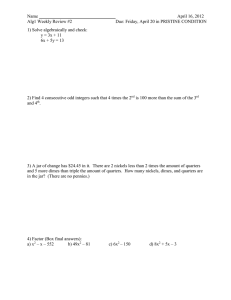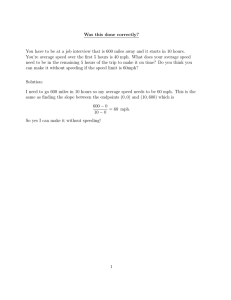Q1 Test 1 Section 1: Sets of Numbers
advertisement
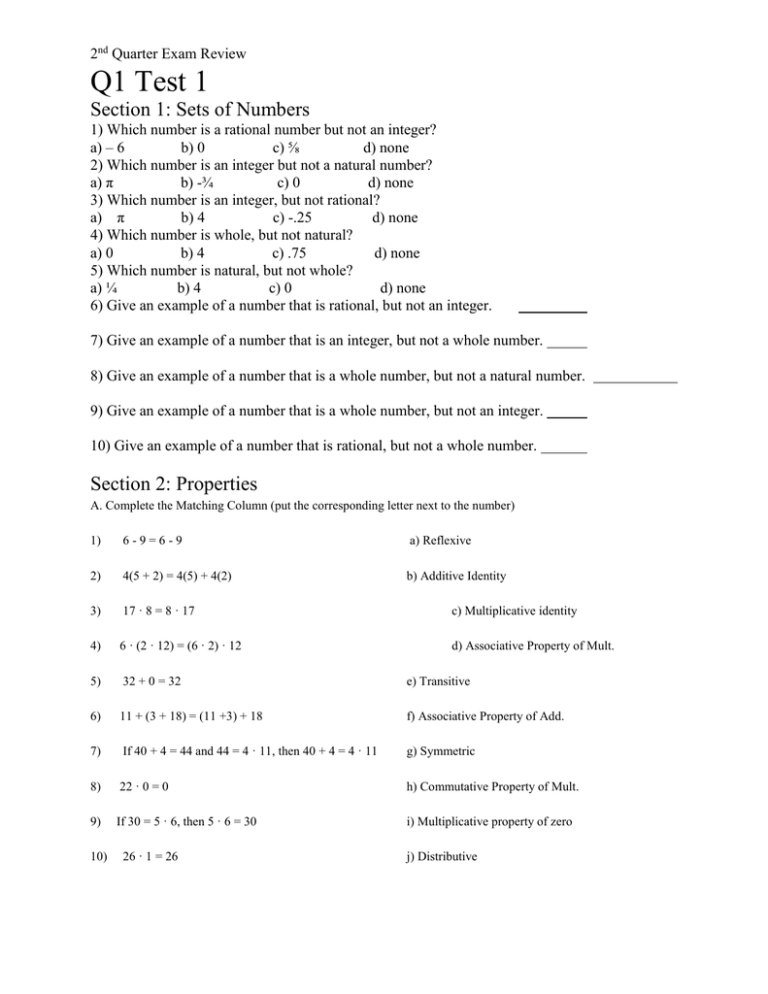
2nd Quarter Exam Review Q1 Test 1 Section 1: Sets of Numbers 1) Which number is a rational number but not an integer? a) – 6 b) 0 c) ⅝ d) none 2) Which number is an integer but not a natural number? a) π b) -¾ c) 0 d) none 3) Which number is an integer, but not rational? a) π b) 4 c) -.25 d) none 4) Which number is whole, but not natural? a) 0 b) 4 c) .75 d) none 5) Which number is natural, but not whole? a) ¼ b) 4 c) 0 d) none 6) Give an example of a number that is rational, but not an integer. 7) Give an example of a number that is an integer, but not a whole number. 8) Give an example of a number that is a whole number, but not a natural number. 9) Give an example of a number that is a whole number, but not an integer. 10) Give an example of a number that is rational, but not a whole number. Section 2: Properties A. Complete the Matching Column (put the corresponding letter next to the number) 1) 6-9=6-9 a) Reflexive 2) 4(5 + 2) = 4(5) + 4(2) b) Additive Identity 3) 17 · 8 = 8 · 17 c) Multiplicative identity 4) 6 · (2 · 12) = (6 · 2) · 12 d) Associative Property of Mult. 5) 32 + 0 = 32 e) Transitive 6) 11 + (3 + 18) = (11 +3) + 18 f) Associative Property of Add. 7) If 40 + 4 = 44 and 44 = 4 · 11, then 40 + 4 = 4 · 11 g) Symmetric 8) 22 · 0 = 0 h) Commutative Property of Mult. 9) If 30 = 5 · 6, then 5 · 6 = 30 i) Multiplicative property of zero 10) 26 · 1 = 26 j) Distributive 2nd Quarter Exam Review Section 3: Operations with Signed Numbers Numbers 7-12 will be given in class (mixed numbers are very difficult to type!) 1) 76 + (-28)= 4) -51 – 64 2) -85 + (-23) = 5) 67 – (-74) = 3) –48 + 37 = 6) -101 – (-44) = 7)Mult/Div Fractions 10) 8) 11) 9) 12) Section 4: Order of Operations: 1) 256 – 46 · 3 – 11= 5) Substitute and Evaluate: 3y3 - 2y2 ÷ 10 + 379 = y = -5 2) 24 ÷ (6 – 3 · 4) · 13 = 6) Substitute and Evaluate: b = 7 and c = -2 bc2 ÷ (42 – 4b) – 11c = 2 3) 100 - 12 · ¼ + (6)(-2) = 7) Evaluate when a = -8, b = -3, and c = 9 4b3 + ac – ab - 1 c2 – 16b ÷ a + 8a + 2b Section 5: Simplifying and Solving Equations 1) (6x - 5) + (7x + 7) 2) (6x2 – 5x + 7) + (9x2 – 4x + 8) 3) 4(3x – 5) + 6(4x + 3) 4) 5(6x – 9) – 7(4x – 8) 5)8(3x2 – 4x + 9) + 6(4x2 + 5x – 12) 6) 9(4x2 + 3x – 8) – 7(6x2 – 4x + 10) 7) 6(2x – 5) + 3(3x + 2) = 102 8) 5(5x – 6) = 6(3x + 2) 9) 63 – ¾ x = 27 10) 10(3x + 1) – 6(7x + 2) = 4 11) 8(7x – 12) = 6(5x – 3) 2nd Quarter Exam Review Q1 Test 2 Section I: Solving Equations: Solve Each Equation: 1) 8x – 5 = -37 3) ⅔x + 11 = 5 5) 6(2x – 5) + 3(3x + 2) = 39 7) 8(3x + 1) – 6(5x + 2) = 56 9) 10(3x + 1) – 6(7x + 2) = 4 2) 34 – 6x = 52 4) 23 - ⅝x = 8 6) 11x + 4 = 9x – 6 8)5(7x – 2) = 6(4x – 9) 10) 8(7x – 12) = 6(5x – 3 Section II: Solving Absolute Value Equations: Solve Each Equation: 1) 3|6x – 12| + 5 = 95 2) ½ |8x + 2| + 24 = 21 3) 3|16x + 24| - 13 = 59 4) 2|9x- 18| _ - 34 = 2 5 5) 4|3x – 3|__ + 22 = -2 -11 6) 3|4x – 12| _ - 4 = 4 9 7) 3|7x + 21| - 1 = 10 2 8) 5|11x – 22| + 1 = 69 4 Section III: Solving Simple Inequalities: 1) 11x + 8 > - 25 3) 6x + 7 < -2 5) 8(4x + 2) – 7(6x – 2) < 50 2) 24 – ½ x < 9 4) 11(2x + 1) > 9(3x – 1) 6) 60 > 7(4x + 2) – 6(6x – 2) Section IV: Solving Compound and Absolute Value Inequalities: 1) -17 < ⅝x – 12 < -12 3) 21 – 4x > 33 U 4(3x – 1) > 56 5) -14 < ⅓x – 12 < -12 7) -3 |12 - ⅔x| > -30 2) 3(4x – 5) < -51 ∩ 15 – ½ x < 13 4) 5(4x – 3) > -35 OR 15 - ¾x < 12 6) 6(½x – 3) < -30 V 15 - ¾x > 12 8) ½ |6x – 12| + 5 > 8 9) 3| 8x – 4 | 12 10) 2 | 12x – 4 | - 11 . -7 + 14 > 23 11) 2|6x – 12| + 11 > -3 12) -4|5x – 10| - 22 > 6 < -11 2nd Quarter Exam Review Q2 Test 1 1) Two buses leave the station at the same time. One is traveling south at a speed of 68 mph. The other is traveling south at 54 mph. How long until they are 50.4 miles apart? 2) Two planes leave the airport at the same time. One is traveling north at a speed of 184 mph. The other is traveling south at 223 mph. How long until they are 1,200.65 miles apart? 3) Maggie’s first 5 grades were 91, 88, 98, 81, and 94. What does she need on her next test in order to have a 90 average? 4) A bus driver is driving from California to Arkansas. He drives 5 hours at 72 mph, 5 and a half hours at 58 mph, 2 hours at 71 mph, and 1 and a half hours at 61 mph. What is his average speed for the trip? Round to the nearest hundredth. 5) Jill had 3 88’s, a 100, and 2 94’s. What is her average? 6) A jar of change has $56.70 in it. There are 7 less dimes than triple the quarters. There are 4 more nickels than 5 times the amount of quarters. How many nickels, dimes, and quarters are in the jar? (There are no pennies.) 7) A phone call cost $2.70. Introductory minutes cost $.18/min and additional minutes are $.09/min. If there were 5 less additional minutes than triple the introductory minutes, how many minutes were billed at each rate? 8) A store sells hats for $17 and ties for $24. Last weekend the store sold 6 more hats than 4 times the amount of ties and the sales were $5,714. How many of each were sold? 9) There are 140 coins in a jar. Some of them are quarters and some of them are dimes. If there is $26.15 in the jar, how many of each coin are there? 10) A 32-minute phone call cost $3.12. Introductory minutes cost $.15/min and additional minutes are $.08/min. How many minutes were billed at each rate? 11) A Knicks hat cost $17 and a Suns hat costs $30. If the store 7 more Suns hats than 11 times the amount of Knicks, and total sales were $557, how many of each did the store sell? 12) Billy’s cell phone company’s daytime rate is $.18/minute and nighttime rate (after 8:00 PM) is $.10/minute. When she got her bill she saw a 28-minute phone call that cost $4.16. When did the call begin? When did it end? 13) Find 5 consecutive odd integers with the sum of -1,065. What is the product of the 2nd and 5th? 14) Find 6 consecutive integers such that the sum of the 3rd and 6th is 377. What is the sum of the 1st and 4th? 15) Find 4 consecutive even integers such that 4 times the 1st is 166 less than the sum of the 2nd and the 3rd. 2nd Quarter Exam Review Q2 Test 2 Part I: Find the equation in slope intercept form and graph: (3 on each set of axis, to save paper) 1) (-3, 6)(4, -8) 2) (3, 5)(-6, -1) 3) (4, -6)(-4, -6) 4) m = - ¾ (-8, 7) 5) m = 2 (5, 6) 6) m = undefined (3,8) 7) y - 5 = ¼(x - 4) 8) 48x - 12y = 72 9) y + 2 = (-3/5)(x - 10) 10) 54x + 18y = 36 11) 55x - 22y = 66 12) y - 4 = (-1/3)(x + 3) Part II: For each problem: a) Find the equation in slope intercept form. b) Find the equation of a line parallel to the line in part a) passing through the given point. c) Find the equation of a line perpendicular to the line in part a) passing through the given point. d) Graph each line on the same set of coordinate axis. 1) a) (4, 3)(-4, -13) b) (3, 7) c) (-8, 1) 2) a) (-4, 8)(2, -1) b) (-6, 5) c) (12, 8) 3) a) (7, 7) (7, -5) b) (-4, 5) c) (6, -2) 4) a) 48x – 36y = 36 b) (6, 12) c) (4, -2) Part III: Solve each system graphically 1) y = 2x - 5 y = - ½x + 5 2) 15x + 15y = 75 y + 6 = (3/2)(x + 4) 3) y - 3 = ¾ (x - 8) 34x – 17y = -34 4) 24x - 18y = -18 y = -7 5) y - 2 = (- ⅓)(x - 9) 27x – 9y = 45 6) x = 3 y + 15 = (-5/3)(x - 9)
